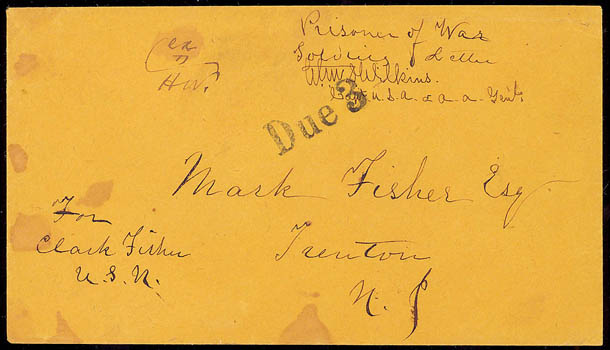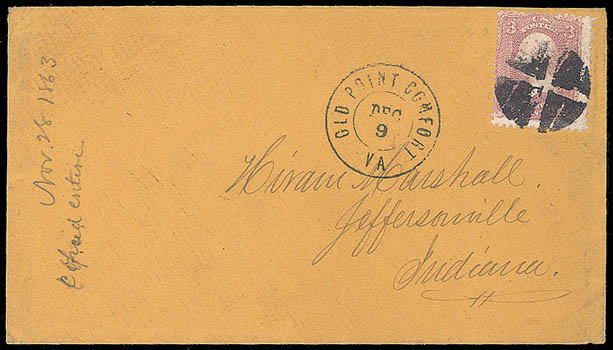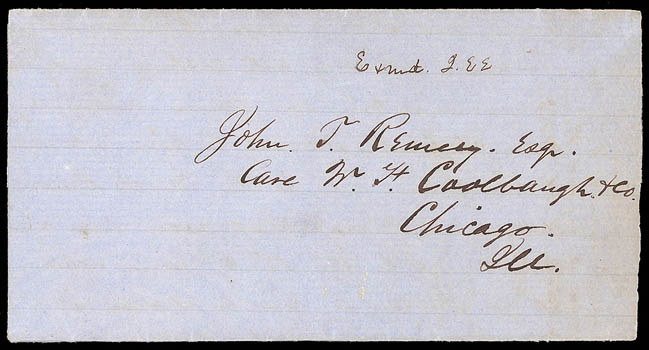
Lot
2529 
Confederacy, Danville Prison, Building #6, Danville, Va., turned prisoner cover bearing CSA 1863, 10¢ greenish blue cancelled by manuscript on cover addressed to "Thos. O Connell, Prison No. 6, Danville, Virginia" and endorsed "Care Genl Winder, Richmond Va" and manuscript "Exd./H.W." examiner's marking of Henry Wassels, Commissary of Prisoners, stamp torn off at upper right, open on three sides and two flaps missing, Fine, Only two covers are known to or from Building #6. Scott No. 12c Estimate $400 - 600.
Brig. General Henry Walton Wessells graduated West Point in 1833. After serving at Kinston, Goldsboro and New Berne, he was placed over the sub-district of the Albemarle, taking command May 3, 1863. On April 17, 1864, he was attacked at Plymouth N.C. by Gen. Robert F. Hoke where he was vastly outnumbered. After a gallant defense that last three days, Gen. Wessels surrendered. He was taken to Libby prison and from there transferred successively to Danville, Macon and Charleston. At the last-named place he was one of the officers placed under the fire of the Union batteries on Morris Island - the Union "600". On Aug. 3, 1864, he was exchanged, and on Nov. 11 he became Commissary of Prisoners, which post he held until the close of the war. He was promoted Lt. Colonel Feb. 16, 1865 and breveted Colonel to date from April 20, 1864 "for gallant and meritorious services during the rebel attack on Plymouth, N.C." On March 13, he was given the regular army brevet of brigadier-general, He then served on the northwestern frontier till January 1, 1871 when he retired.
The prison at Danville consisted of six tobacco warehouses plus a hospital. They were used November 1863 through the end of the war. This building housed many Federal soldiers captured in the battle of the Crater in Petersburg in July 1864.

Lot
2530 
Confederacy, General Hospital No. 21, Richmond, Va., printed form voucher dated Feb 16, 1865 for $1,500 for 50 bushels of potatoes exclusively for the use of the sick and wounded prisoners of war, signed "G. Wm. Semple" as surgeon in charge, slight aging with clipped corner, F.-V.F., a scarce item from this prison, only five cover are recorded. Estimate $300 - 400.
General Hospital No. 21, also known as Gwalthmey Factory Hospital or C.S. Prison Military Hospital, was a converted tobacco factory located at the corner of 25th and Cary streets and was part of the Confederate prison system. The hospital housed sick and wounded Union POWs, both officer and enlisted with a capacity of 700. POWs at this prison were treated as well as the Confederacy could provide.
Realized: $450

Lot
2531 
Confederacy, Libby Prison, Richmond, Va., orange prisoner-of-war cover to Mark Fisher Esq. in Trenton N.J., unusual soldier's letter endorsement provided by fellow prisoner, Captain William D. Wilkins, "For Clark Fisher U.S.A." and additional "Prisoner of War, Soldiers Letter" at top, censored with manuscript "exd HW." by Captain Henry H. Wirz, later of Andersonville Prison infamy, "Due 3" handstamp for U.S. rating; couple minor stained spots, Very Fine, ex-Walske. Estimate $1,500 - 2,000.
A RARE EXAMPLE OF THE COMMANDANT HENRY WIRZ'S CENSOR MARKING ON A FLAG-OF-TRUCE COVER FROM LIBBY PRISON.
Henry H. Wirz took command of Libby Prison beginning in late 1862. In March 1864, he was assigned to Andersonville (Camp Sumter). After the war, Wirz was charged with conspiracy and murder by Federal authorities. His trial was held in the Capitol building in Washington and was presided over by Union General Lew Wallace. A number of former prisoners testified on conditions at Andersonville, many accusing Wirz of specific acts of cruelty (some of these accounts were later called into question by historians as exaggerated or false). The court also heard from Confederate officers and considered official correspondence from captured Confederate records. Wirz presented evidence that he pleaded to Confederate authorities to try to get more food and maintained that he tried to improve the conditions for the prisoners. Wirz was found guilty of murder and was sentenced to death. On November 10, 1865, he was hanged in Washington at the site of the current Supreme Court building -- the only Confederate official to be tried, convicted and executed for war crimes resulting from the Civil War.
References: Illustrated in Harrison on page 92.
Realized: $750

Lot
2532 
Confederacy, Libby Prison, Richmond, Va., Prisoner cover with "Old Point Comfort Va. Nov 10" double circle date stamp and matching "Due 6" circled handstamp, endorsed "M. M. Moore, 2nd Lieut, Prisoner of War" at left and addressed to his mother Mrs. A. W. Moore at Grand Rapids Mich., Feb. 14, 1864 letter from same correspondence accompanies where he states he is able to only write six lines and he expects to stay in prison for the duration of the war, Very Fine. Estimate $750 - 1,000.
He was in fact exchanged or released in early 1865 and rejoined his unit on April 1, 1865 and did not muster out of service until November 24, 1865.
Realized: $575

Lot
2533 
Confederacy, Libby Prison, Richmond, Va., orange cover bearing U.S. 1861, 3¢ rose tied by cork cancel and with matching "Old Point Comfort Va. Dec 9" cds, addressed to Hiram Marshall at Jefferson Ind., letter sent from William S. Marshall with pencil "Nov. 28 1863 contents docketing at left, Very Fine, ex-Walske, Hedin. Estimate $500 - 750.
William S. Marshall was Adjutant of the 51st Regiment Indiana Volunteer Infantry. He was in the line of duty near Rome, Ga. as 1st Sergeant on or about May 3, 1863 when he was captured at Rowe Gap while making a raid under the command of Col. A.D. Steight. He was held prisoner of war at Libby Prison from May 16, 1863 until May 7, 1864. He was then transferred to Confederate Prisons: Camp Ogelthrope, "Workhouse" near City Jail and Camp Asylum. He tried to escape from prison camp near Columbia S.C. but was recaptured. He escaped from a train of cars on February 14, 1865.
Realized: $350

Lot
2534 
Confederacy, Libby Prison, Richmond, Va., buff prisoner's cover with "Old Point Comfort, Va., Oct 2" cds and matching "Due 6" rating handstamp addressed to Rear Admiral Hiram Paulding, Navy Yard, New York, cover with pencil Examiner's initials, original one page letter from Private William A. Paulding (1842-1906) in Company K of N.Y. 78th Infantry to his parents, Very Fine and choice; with 2004 C.S.A. certificate. Estimate $500 - 750.
The original one page prisoner's letter from Private Paulding to his father is included in which he says he is well and that he received the letter with the $15.00 and was surprised to hear that they have not received his letters as he has been writing every week and taking great care not to include anything that would be objectionable to the examiners. The letter is datelined "Libby Prison Richmond Sept 23 63." Private Paulding was first captured as a POW at Salem Church during the Chancelorsville Campaign on May 4, 1863 but was very soon paroled and exchanged. He rejoined his regiment in time for Gettysburg where he was slightly wounded and again captured as a POW on July 3, 1863. This time he was confined at Libby Prison until exchanged and released in early 1864. His release was due to a special exchange possibly because of the prominence of his family.
Realized: $500

Lot
2535 
Confederacy, Prisoners Hospital, Charleston, S.C., January 27, 1864 dateline on part of letter from the Steward requesting "3 spittoons wash basin and the tin bucket that was sent for this hospital…"; small flaws, Fine. Estimate $200 - 300.


Lot
2536 
Confederacy, Richland Jail, Columbia, S.C., dateline on inner letter "Columbia Jail S.C. July 1st 1864" from Lieut. George C. Remey, U.S. N. concerning personal business to his brother John T. Remey at Chicago Ill., inner letter with manuscript "Exmd. I. E. E." and with blue "Received Hd. Qrs., Jul 16, 1864, Dept. South" circular handstamp, forwarded from Washington D.C. with free franked Commissary General of Prisoners, Official Business envelope with "W. Hoffman" handstamp and ms. "Com Gen Pris" below, a bit trimmed at top; F.-V.F., A very scarce use officially forwarded by the Commissary General. Estimate $1,000 - 1,500.
A REMARKABLY RARE PRISONER OF WAR USE FROM A CAPTURED FEDERAL NAVAL OFFICER HELD IN A SOUTHERN PRISON.
Remey was born at Burlington, Iowa, and graduated from the United States Naval Academy in 1859. Initially assigned to the sloop USS Hartford on the Asiatic Station, he returned to the United States with the outbreak of the Civil War and served in the gunboat Marblehead during the Peninsular Campaign, March-July 1862; and, afterward, in the blockade of Charleston. In April 1863 he assumed duties as Executive Officer in the screw sloop Canandaigua and during attacks on Fort Wagner briefly commanded Marblehead. From 23 August to 7 September, he commanded a battery of naval guns on Morris Island, and on the night of 7-8 September led the second division of a boat attack on Fort Sumter. The division made shore, but was smashed by gunfire. Remey and the surviving members of his party were forced to surrender. Following 13 months of imprisonment at Columbia, S.C., Remey was exchanged and returned to duty, serving in the sidewheel steamship De Soto until the end of the war.
In 1866 he saw service off the west coast of South America and in 1870-71 participated in the Tehuantepec Survey Expedition. After commanding the screw sloop Enterprise and service in the Mediterranean, he was appointed captain, 1885, and four years later assumed command of the protected cruiser Charleston, flagship of the Pacific Squadron. Commandant of the Portsmouth Navy Yard at the outbreak of the Spanish-American War, he was ordered to take charge of the Naval Base Key West, whence he directed the supply and repair of all naval forces in Cuban waters and organized supply lines to Army forces in Cuba. After peace returned, Rear Admiral Remey resumed duties at the Portsmouth Navy Yard. In April 1900, he assumed command of the Asiatic Station and for the next two years guided the ships of that station through the diplomatic and military chaos that was China. He then returned to the United States and served for a year as Chairman of the Lighthouse Board before retiring 10 August 1903. Rear Admiral Remey died at Washington, D.C. on 10 February 1928.
Realized: $800

Lot
2537 
Confederacy, Roper Hospital, Charleston, S.C., September 29th, 1864 dateline on prisoner of war letter from Capt. E.L. Smith of the 19th Infantry, he writes to his father to send money and starts with "Captain Bird, going North tomorrow & finally exchanged, had permission to carry a few lines from his friends"; file folds, F.-V.F. Estimate $150 - 200.
Realized: $95

Lot
2538 
Confederacy, Roper Hospital, Charleston, S.C., prisoner of war adversity cover made out of lined paper addressed to Miss Mary H. Harmer in New York City, with "Port Royal, S.C. Sep 29, 1864" cds and matching "Due 3" rating handstamp, endorsed "Prisoners letter, by Flag of Truce" and "Ex'd" examiner's marking, reverse with "Soldier's Letter, Stewart L. Woodford, Lt. Col, Agent of Exchange" endorsement; cover with two small tears at the top and sealed flap tears, F.-V.F.; with 2001 C.S.A. certificate. Estimate $750 - 1,000.
A SCARCE PRISONER USE FROM ROPER HOSPITAL, THERE ARE 19 COVERS RECORDED.
Realized: $500
